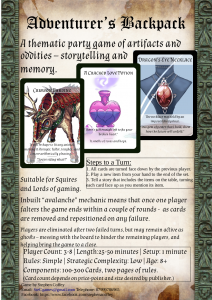Adventurer’s Backpack Sell Sheet
So, for today I’m going to be looking at the sell-sheet for our main current card-game project, it design and a breakdown of what we’ve put in there.
This is not a how-to guide – it’s a how-I-did log: much of it is being written as the process is ongoing.
Step One: Look for Advice
I’ll start by linking a how-to guide, because that’s where I started on making the sheet.
Step Two: The Base Statistics of the Game:
How long does it take to play?
That varies, of course, but with timed playtests we’ve determined that it lasted 20-60 minutes. With a few minor rules adjustments, to allow compensating for player count and experience, it fits in the range of 25-50 minutes. Still a large variance, but not quite as extreme, and something that may be reducible further – but sell-sheets need to reflect the game as-is, not as-desired: a publisher won’t look kindly on a designer who deceives them from first interaction!
How many players can it take?
For Adventurer’s Backpack that’s a hard one to answer – technically it could be played with 20 players with no need to change the rules – but it would just be frustrating at that point. Deciding a cut-off for “How fun is fun enough” is necessarily arbitrary, but we went with a max of 8 players because we’ve been unable to playtest with 9 enough to say for sure, and 11 players is certainly no longer fun.
On the other end, it’s technically possible to play Adventurer’s Backpack solo – as a simple memory game – but it loses its greatest strength, the way that storytelling aids and influences memory! With two players the game works, but to my mind lacks most of its charm – so 3-8 it is.
What age is it for?
This one I actually missed out at first – a clerical error that I’ve just corrected. From our testing, some children as young as 6 may have fun with the game, but the combination of structured gameplay and freeform storytelling doesn’t always sink through – while we’ve only had a few playtests with children we believe that from age 8 most children will be able to grasp the game.
What components does it need?
It’s easy to forget this one – it doesn’t go on the outside of the game box like the others – but it’s absolutely vital. When it comes to mass-producing a game the materials needed and the manufacturing costs are vital – if the game is too expensive to make, then it’s not worth making; the more expensive it is the more it has to be able to grab its audience!
And Another Thing…
While not part of the standard set, I chose to include two/three further “stats” with those core ones:
Setup time – Most of our games are very quick to set up, and long set-ups can get frustrating, so keeping that clear in the core facts is valuable.
Rules and Strategic Complexity: The age range for a game is often used as a rough-and-ready guide to this, but the two can be very different – take Cards Against Humanity: it’s rules complexity is low, and its strategic complexity is zero, but it’s still at least a 12+ on age.

Step Three: Contact Details
There’s no point making an amazing sell-sheet if you don’t provide a way for the publisher to contact you after they read it. At best you’ll find that the idea percolates and they come up with something better that’s inspired by you – more likely they’ll just forget about you and throw the sheet away, mildly irritated.
Step Four: The Hook
In one sentence explain the game – and make it sound cool. Sometimes that means thematics, sometimes pointing to a new mechanic, but it needs to hook them straight away.
I struggle with this, and I never feel my hooks are good enough, but after the fifth revision I take my hands off and accept the best I can do.
Step Five: Visuals
You might not have good art – in fact you probably don’t – but you need to have some form of image to give the reader a break from the wall of text, often an image of your prototype in play. In the case of Adventurer’s Backpack the cards themselves are image heavy, and are the sole focus of the gameplay, so we can zoom on those to show what the game involves.
For art we used a mixture of Creative Commons and Public Domain art alongside stock art from various artists (purchased on DriveThruRPG). If you don’t have good access to art learning to find useable art is a key skill in my opinion. (Quick tip: https://search.creativecommons.org is a goldmine – but it’s not everything, and it’s not infallible, so be sure to double check that you know the true source of the image)
Step Six: Gameplay Specials
In the body of the text you need to pull out the most valuable pieces of unique (or simply rare) gameplay – or whatever combination of elements makes the game something special.
Step Seven: Play Synopsis
Somewhere on the sheet you need to explain what a basic “gameplay loop” of your game looks like – what do you do each round?
And that’s it… aside from the inevitable realisation that you’ve missed something just after you send it out!
